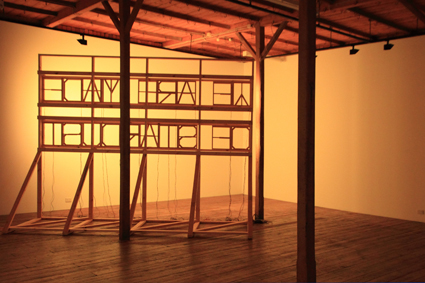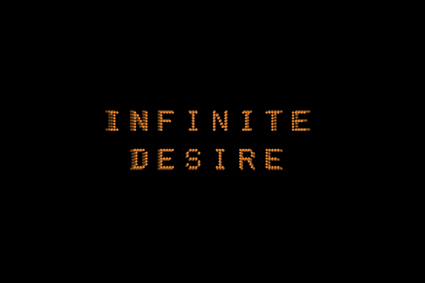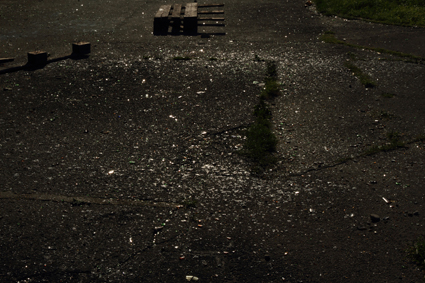A universe of everyday desires
Urszula Dawkins: Michaela Gleave, Universal Truths

Michaela Gleave, We Are Made of Stardust, 2013
courtesy of the artist and Anna Pappas Gallery
Michaela Gleave, We Are Made of Stardust, 2013
The expression “We are made of stardust” both positions humankind within a vast, magnificent universe and reduces us, notionally, to the ashes of which everything consists. It’s the central message—at face value, at least—of Michaela Gleave’s Universal Truths, an exploration of the search for meaning inspired by a research residency with the CSIRO’s Astronomy and Space Science Division.
At Anna Pappas Gallery in Melbourne, Universal Truths comprised five works ranging from the quietly mesmerising We Are Made of Stardust—a large billboard-like installation emanating coloured LED light along with its message—to smaller LED pieces and a series of Lambda prints on photographic rag paper. The works responded in different but interrelated ways to the artist’s time at facilities including the Australia Telescope Compact Array at Narrabri and the Bureau of Meteorology solar observatory on the same site.
Asked about the ideas the residency prompted, Gleave first describes her fascination with the language she encountered—hearing how astronomers use the word ‘sky’ for example, “which I’d thought might be a very old-fashioned way of approaching the universe,” and discovering first-hand how the terminology used exposes the historical evolution of science.
“The residency made me acutely aware of how fleeting ideas about reality can be, especially in astronomy, where the field is leaping ahead in such vast steps […] I also thought a lot about the knowledge that is left behind by so-called advances: there is a process of forgetting that comes about through the de-valuing of older knowledge systems, and we potentially lose valuable ‘truths’ as a result.”
Ultimately, says Gleave, the science of cosmology is “just about trying to find meaning in our own lives. It becomes about how we see ourselves in relation to our surroundings.”
We Are Made of Stardust dominated the small upstairs room at Anna Pappas. On a utilitarian wooden frame were arrayed hundreds of LEDs, spelling out the work’s eponymous message and linked to an RGB controller, wiring exposed and dangling. The coloured light morphed through the rainbow—pink to red to vermilion to gold to lemon to lime to emerald and beyond—a visually lush reference to advertising, constellations, starfields. Crucially, the entire structure was positioned to face the meeting of two walls, rendering the message obscure until the viewer walked into its blind corner. From ‘inside’ the corner the words shone bright, searing into the retina; while ‘outside’ the impression was of nebulous but ever-present influence.
The glowing LEDs are, says Gleave, an extension of previous experiments with light as a tactile medium; suggesting romance and whimsy, as well as advertising’s false promises.
“With We Are Made of Stardust I [also] wanted to capture the extreme senses of scale that are often behind my atmospheric installations, using text as a means of conveying large ideas whilst maintaining a very personal and tactile response to the physicality of the object and the present-ness of the individual’s experience. Billboards are vehicles for fiction, often used to stand in for much larger physical presences.”

Michaela Gleave, Infinite Desire, 2013
courtesy of the artist and Anna Pappas Gallery
Michaela Gleave, Infinite Desire, 2013
A pair of small works, Universal Truth and Infinite Desire, echoed We Are Made of Stardust with their aspirational sentiment; each was a small wall-mounted sign, again made of LEDs, referencing, in Gleave’s words, “tacky signs hanging in convenience store windows or cheap beauty salons, hyper-luminous…” In their deep box frames, between panes of dark glass, the LEDs, mounted at the front surface, reflected their monochromatic dots of light off the back panel to create a receding procession of images; truth and desire fading into a false third dimension. The signs drew attention humbly, while around them on the white walls the shifting colours of the larger work provided a constant reminder of that eternally morphic stardust.
“The text in [both Universal Truth and Infinite Desire] recedes into the infinite darkness,” says Gleave, “[they are] bittersweet pronouncements commenting on the contradictions of our human desire for understanding. There are no universal truths when even the speed of light, thought to be a universal constant, has been seen to change. And despite science telling us that there is no meaning to life, science’s very existence is due to the persistent human desire to find meaning.”
Model for the end of the universe (1–4) and Untitled (Teufelsberg, 2010) scaled the viewer’s experience down further, towards its limits. The former, a series of four Lambda prints, presented sets of small symbols on deep black backgrounds—curving arrowheads, or little dots like abstracted entities. Each print refers to a potential entropic ‘end-point’ proposed by current scientific thinking, says Gleave; they are based around dance notation and created as “an event-based score.” The latter work was a photograph—a close-up of concrete tarmac covered in fragments of broken glass. The image, so pedestrian, seemed to zoom back out to infinite scale, asking ‘where are we in all this?’

Michaela Gleave, Untitled (Teufelsberg 2010), 2010
courtesy of the artist and Anna Pappas Gallery
Michaela Gleave, Untitled (Teufelsberg 2010), 2010
Gleave points to the inevitable interpretations of images that, as humans, we’re driven to make: “The broken glass appears as a field of stars, blues and reds refracted from the white light, with cracks in the concrete and strips of grass standing in for the dark of gas clouds. […] To me this image is a partner piece for the billboard. We are made of stardust, yet ultimately we’re grounded and our immediate present is all we really have.”
Though dominated by its quasi-billboard, Universal Truths was an understated show, requiring—and rewarding—contemplation. Somewhat coolly, Michaela Gleave presented a field of observation, referencing the stars but subtly illuminating points of reference closer to home: our billboards and petty concerns, blinking lights and everyday desires. Far from suggesting that we are insignificant, the work somehow raised pavement debris, consumer-driven desire, human finitude and the mysteries of the universe to the same level. The ‘gallery space’ perhaps mirrored ‘outer space’—distant and inscrutable at first, but opening up to investigation. Not quite able to place ourselves, visitors were there, nevertheless, bathed in light—observers implicated (and somehow validated) in the process of observing.
Michaela Gleave, Universal Truths, Anna Pappas Gallery, Prahran, Melbourne, 2 July-3 August, 2013; http://annapappasgallery.com/
See also Darren Jorgensen’s review of A day is longer than a year at PICA
This article first appeared as part of RT’s online e-dition 11 Sept, 2013
RealTime issue #117 Oct-Nov 2013 pg. 45






